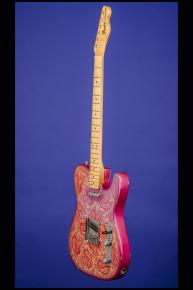An all Original and Near Fine Pink-Paisley 'Maple-Cap' Telecaster
"Paisley Red pulsates with every beat and swirls in a blinding carousel of color forms and tones…"
1968 Fender Telecaster (Pink Paisley)This very early 'maple-cap' neck Paisley Telecaster weighs just 7.70 lbs. Solid alder body with the original Paisley finish. Two-piece maple-cap neck with a nut width of just under 1 5/8 inches, a scale length of 25 1/2 inches, and a wonderful medium-to-thick profile. Maple-cap fretboard with twenty-one original medium frets and black dot position markers. Headstock with CBS 'black' logo with "Fender" in black with gold trim, "Telecaster" in black, and two patent numbers "2,573,254" and "3,143,028" beneath. Single butterfly string tree. Individual Fender "F" tuners with octagonal metal buttons. Four-bolt neckplate with Fender backward "F" logo and serial number "240006" between the top two screws. The neck is stamped "3 JUL 68B" One plain metal-cover pickup at neck with an output of 4.94k and one black six staggered polepiece pickup angled in bridge-plate with an output of 5.95k. Clear plastic pickguard (6mm. thick) with eight screws and 'sprayed' pink area on the underside of the aperture for the neck pickup. Two controls (one volume, one tone) plus three-way selector switch, all on metal plate adjoining pickguard. The wiring is of the earlier cloth type. The potentiometers are stamped "304 6617" (Stackpole April 1966). Chrome knobs with almost flat tops and knurled sides. Fender combined bridge and tailpiece with three individually adjustable grooved steel saddles. There is some fine finish checking on the body and a few light cracks in the polyester clear-coat - but there is none of the dreaded and unfortunately very common heavy cracking and peeling of the Paisley 'paper' under the clear-coat. The 'Pink Paisley' finish is bright and fresh without the usual fading… there is some natural playing wear on the bass-side of the top and one small surface chip on the treble-side of the top edge and four small surface chips on the treble-side lower edge. The maple fretboard shows some playing wear on the first eight frets and there is some playing wear on the treble-edge of the neck affecting the first twelve frets. The original frets show some light playing wear which is confined to the first ten frets. Otherwise this is one of the cleanest and most colorful 'Paisley's' that we have ever seen and is in exceptionally fine (9.00) condition. Complete with the original 'ashtray' bridge cover. A wonderful looking, playing and sounding guitar… Housed in it's original Fender three-latch rectangular black hardshell case with reddish orange plush lining and black leather ends (8.75).
"1968 also witnessed the introduction of two additional versions of the Telecaster: the PAISLEY RED and BLUE FLOWER models. Based on regular maple board Tellies, the two guitars were fitted with finishes meant to capitalize upon the emergence of Flower Power in San Francisco. The accompanying captions on the Fender leaflet were indeed worded in a contemporary spirit: "Paisley Red pulsates with every beat and swirls in a blinding carousel of color forms and tones…" and "Blue Flower bursts forth in a dazzling array of subtle purple and green patterns…" Both finishes were achieved with stickum wallpaper applied on the top and back of the body and then sprayed with polyester. The success of the two models was not, however, as spectacular as their Paisley and Floral graphics which at the time were also available on the Telecaster Bass. Both versions were discontinued in 1969 when the San Francisco sound gave way to the early flurries of metal rock à la Led Zeppelin. (A.R. Duchossoir. The Fender Telecaster, p.23).
The earliest Paisley Telecaster shown in Werner's List is serial # 220667 with a neck date of May 1968. Our guitar is the earliest Paisley Telecaster that we have handled.
"Out of the psychedelic era came the paisley finish, which is actually adhesive-backed paper oversprayed with a polyester clear coat" (George Gruhn and Walter Carter, Electric Guitars and Basses, p. 147).













